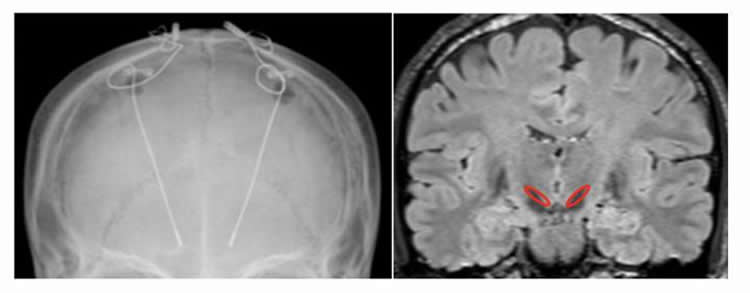Summary: Researchers have developed a neurofeedback system which allows Parkinson’s patients to voluntarily control beta wave activity in the subthalamic nucleus.
Source: Osaka University.
Parkinson’s disease is associated with abnormal beta wave activity in the subthalamic nucleus (STN), but a direct connection between this activity and movement difficulties has not yet been established.
A study group at Osaka University developed a neurofeedback system which enables patients with Parkinson’s disease to voluntarily control beta wave activity in their deep brain (STN) associated with symptoms of the disorder. The group demonstrated that the patients can control these beta waves voluntary; however, it remains to be determined whether such a system can provide symptom relief. The group’s research results were published in eNeuro.
“In a study of eight patients undergoing a routine replacement of a pulse generator used for deep brain stimulation, we developed a method that could help scientists better understand the relationship between brain activity and disease symptoms,” says senior author Haruhiko Kishima.

In this study, the patients were trained to increase the size of a black circle that changes according to the participants’ real-time beta wave activity. For half of the participants, the size of the black circle was positively correlated with beta wave intensity, and for other half of the participants, the circle was negatively correlated with beta wave intensity. After the 10 minutes of training, the study demonstrated that the patients’ beta waves significantly increased or decreased depending on the circle condition. Using the real-time feedback system, the patients can voluntarily control their beta waves.
Corresponding author Takufumi Yanagisawa says, “Although we did not observe an improvement in patients’ symptoms, our study represents a new approach toward managing disease-related brain activity that could lead to the development of new treatments.”
Funding: Japan Agency for Medical Research and Development (AMED) funded this study.
Source: Saori Obayashi – Osaka University
Publisher: Organized by NeuroscienceNews.com.
Image Source: NeuroscienceNews.com image is credited to Osaka University.
Original Research: Open access research for “Real-Time Neurofeedback to Modulate β-Band Power in the Subthalamic Nucleus in Parkinson’s Disease Patients” by Ryohei Fukuma, Takufumi Yanagisawa, Masataka Tanaka, Fumiaki Yoshida, Koichi Hosomi, Satoru Oshino, Naoki Tani and Haruhiko Kishima in eNeuro. Published February 2019.
doi:10.1523/ENEURO.0246-18.2018
[cbtabs][cbtab title=”MLA”]Osaka University”Voluntary Control of Brainwaves in Deep Brain of Parkinson’s Patients.” NeuroscienceNews. NeuroscienceNews, 6 February 2019.
<https://neurosciencenews.com/parkinsons-brain-waves-conrol-10702/>.[/cbtab][cbtab title=”APA”]Osaka University(2019, February 6). Voluntary Control of Brainwaves in Deep Brain of Parkinson’s Patients. NeuroscienceNews. Retrieved February 6, 2019 from https://neurosciencenews.com/parkinsons-brain-waves-conrol-10702/[/cbtab][cbtab title=”Chicago”]Osaka University”Voluntary Control of Brainwaves in Deep Brain of Parkinson’s Patients.” https://neurosciencenews.com/parkinsons-brain-waves-conrol-10702/ (accessed February 6, 2019).[/cbtab][/cbtabs]
Abstract
Real-Time Neurofeedback to Modulate β-Band Power in the Subthalamic Nucleus in Parkinson’s Disease Patients
The β-band oscillation in the subthalamic nucleus (STN) is a therapeutic target for Parkinson’s disease. Previous studies demonstrated that l-DOPA decreases the β-band (13–30 Hz) oscillations with improvement of motor symptoms. However, it has not been elucidated whether patients with Parkinson’s disease are able to control the β-band oscillation voluntarily. Here, we hypothesized that neurofeedback training to control the β-band power in the STN induces plastic changes in the STN of individuals with Parkinson’s disease. We recorded the signals from STN deep-brain stimulation electrodes during operations to replace implantable pulse generators in eight human patients (3 male) with bilateral electrodes. Four patients were induced to decrease the β-band power during the feedback training (down-training condition), whereas the other patients were induced to increase (up-training condition). All patients were blinded to their assigned condition. Adjacent contacts that showed the highest β-band power were selected for the feedback. During the 10 min training, patients were shown a circle whose diameter was controlled by the β-band power of the selected contacts. Powers in the β-band during 5 min resting sessions recorded before and after the feedback were compared. In the down-training condition, the β-band power of the selected contacts decreased significantly after feedback in all four patients (p < 0.05). In contrast, the β-band power significantly increased after feedback in two of four patients in the up-training condition. Overall, the patients could voluntarily control the β-band power in STN in the instructed direction (p < 0.05) through neurofeedback.






